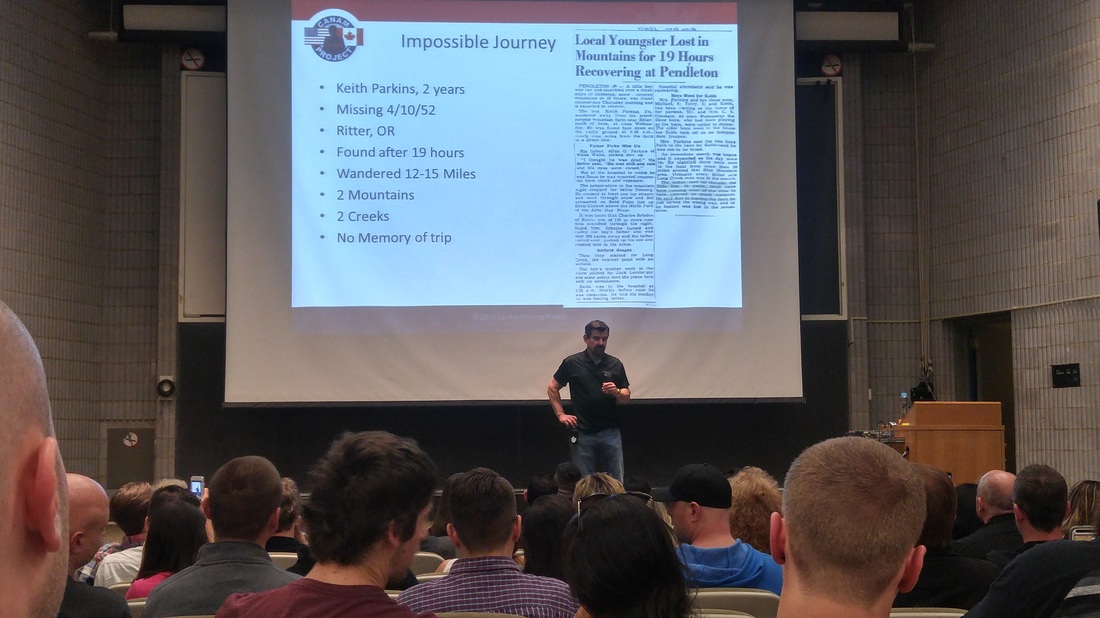Last night, David Paulides, author of the much discussed non-fiction series, Missing 411, gave a talk at the University of Toronto. The talk was organized by the folks at Conspiracy Culture bookstore, a hub for alternative thought in the downtown area which had previously brought the great Graham Hancock to the city. For $20, I thought it could make for an interesting evening.
I first heard Paulides’ work mentioned in the comment section of a popular post on reddit submitted by an anonymous writer who claimed to be a search and rescue officer at an unidentified U.S. national park in the U.S. The writer claimed to have worked on many cases of unexplained, and seemingly inexplicable, disappearances, and some that involved apparently supernatural phenomena. He or she also claimed, remarkably, that it was normal for search and rescue workers to encounter mysterious staircases deep in the wilderness which experienced officers admonished their juniors to avoid. A commenter mentioned the similarity of the writer’s stories to some of the cases presented in Missing 411, and I followed up on the reference.
I’ve yet to read any of the books in the series, but my understanding is that Missing 411 catalogues the hundreds of missing persons cases, primarily in North America, left unaccounted for by local investigators: sudden and inexplicable disappearances in which the body was either never found, or found only much later in highly unusual circumstances. Although Paulides was deeply involved in Bigfoot research for a number of years, he never ascribes a culprit to any of the disappearances he catalogues, but simultaneously insists that conventional explanations - murders, abductions, and suicides, for example - have all been ruled out.
Paulides had a kind of understated presence, but spoke convincingly throughout. He said relatively little about himself, claiming only to have worked as a police officer, an HR professional, and in some advanced position within an unidentified high-tech company. He said nothing of his Bigfoot research, perhaps in a effort to avoid discrediting himself to newcomers unsympathetic to anomalous phenomena, and did not discuss how he became interested in cases of missing persons (most likely because it came up during his investigations into Bigfoot encounters in national parks, something he’s admitted to elsewhere).
The vast majority of Paulides’ talk was spent on reviewing the data he’s collected, with very little in the way of either introductory or concluding remarks. He began by showing a few maps of where the disappearances were clustered (around the Rocky and Appalachian mountain ranges, with virtually no incidents in the Canadian prairies or through the American mid-west), then highlighted a few trends in the data. For example, he mentioned that in cases where a body was eventually found (most cases), autopsies often revealed that the person was not at the location of discovery for all, or even most of the time they were missing. More interestingly, there seems to be some sort of a connection to water: cases do not occur far from any large bodies of water (the prairies), and many bodies are eventually found floating in shallow bodies of water such as rivers, ponds, or marshes. All cases were investigated by local police departments and/ or search and rescue teams, and most were cleared of any suspicion of “foul play.”
Throughout his talk, Paulides reminded the audience why these kinds of cases weren’t compiled earlier: local departments, he claimed, thought locally, and weren’t particularly concerned with - or even aware of - what similar things may have happened on the other side of the continent, or 50 years prior. Their job is to provide details in the case that might help lead to evidence of foul play. If none are found, their job is over, even if other aspects of the case are left unexplained.
Given the great span of time and space over which these disappearances have occurred (Paulides mentioned that the earliest ones go back at least as far as the 19th century), federal investigations units like the FBI have no reason to suspect the work of a serial killer or a secret cult. The cases are effectively disregarded, and inevitably forgotten, much like anomalies in scientific disciplines. As a remedy, Paulides proposed a national, or trans-national investigations unit that could be notified and dispatched in all cases that matched a similar profile. This unit could then test for otherwise unscreened factors (like the presence of GHB, the “date rape” chemical) that Paulides suspects might provide clues as to what is going on.
Paulides offered almost nothing in the way of explanation, although he did highlight a few strange trends in the data. Few of these trends, however, offer any obvious clues in the identification of a culprit, motive, or mechanism for the disappearances. A large percentage of missing persons were runners, physicians, or hunters, for example. There are other clusters of sex and age consistency that are equally as puzzling. Victims tend to be bright, happy, and upstanding people, with no reason for ending their own life. They tend to disappear one-at-a-time (rarely in pairs), and strangely, their shoes are almost never found. Most bodies, when discovered, are found in socks or barefoot, and often completely naked. Often they are found miles from the place of disappearance, across natural barriers they could scarcely have traversed on their own. Other peculiar details are far too varied and nuanced to list here.
Pauldies spoke for a little more than an hour and a half, then allowed some time for Q&A. I was pleased when an audience member asked Paulides about the alleged forest stairs made popular in the reddit post mentioned above. I had wanted to ask him about this myself, but wasn’t sure if I’d get a chance at the mic. Paulides immediately identified the forest stairs as a myth, propagated by fans of his work looking to generate a few easy hits, or up-votes, as it were, online. He didn’t dwell on the subject for more than a few sentences, but he insisted that the hundreds of search and rescue workers he’s interviewed in his career have never mentioned any such phenomenon. I left feeling as though the anonymous, reddit-famous search and rescue officer was likely little more than a clever charlatan with a penchant for supernatural horror tales. Oh well, I guess some things are just too intriguing to be true.
All in all, it was a great evening, and I walked away convinced that there was a genuine, undiscovered phenomenon at the heart of these disappearances. I also couldn’t help but be impressed by the bullet-proof nature of the evidence. Contrary to most UFO sightings, for example, in which something comes and goes often without any contact with the surrounding environment, Paulides’ cases involve undeniable deaths and disappearances, often with recovered bodies. These are data that can't be dismissed, and are very difficult to explain away: how could any debunker presume to provide an explanation that the coroner, family, and investigators couldn’t give themselves?
Unfortunately, I did not walk away with a copy of any books in the Missing 411 series, as Paulides misjudged the demand and brought too few copies. I wasn’t particularly disappointed, however, as I felt that Pauldies had provided an adequate review of the data in his talk alone. Whether I ever buy his books or not, I’ll certainly keep an eye on developments in Paulides’ work. You should too.
And I highly recommend that you read into some of the cases chronicled in Missing 411, or watch one of Paulides’ talks on YouTube. The specific circumstances of some of the disappearances are truly bizarre, and far more unsettling than they might seem when discussed as a whole, as I’ve done here. Just don’t be surprised if you lose your enthusiasm for camping.
- Jason Charbonneau



 RSS Feed
RSS Feed

